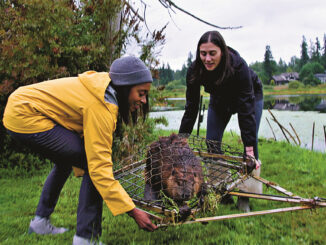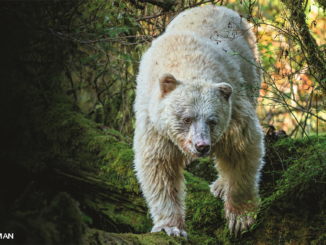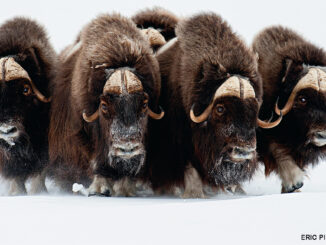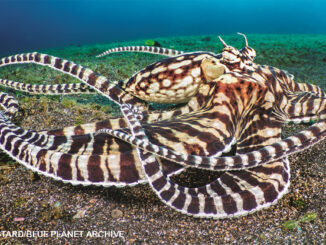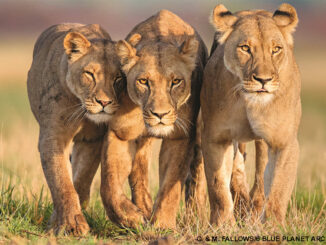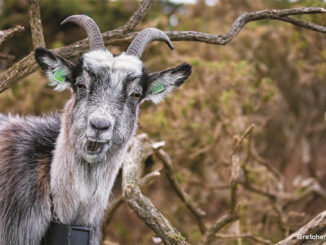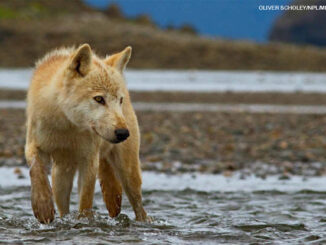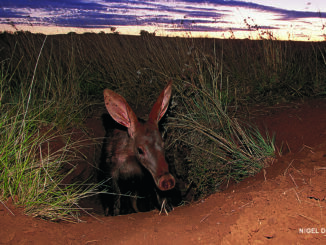
The Real T. rex
By Kathy Kranking; art by James GurneyIt’s not your grandparents’ Tyrannosaurus!

People have always been obsessed with Tyrannosaurus rex—T. rex, for short. And why wouldn’t they be? With a body the length of a school bus, a head longer than you are tall, and a mouth full of gigantic sharp teeth, T. rex is big, bad, and super cool!
But today’s T. rex isn’t the same one your grandparents knew. Its image has changed a lot over time, going from a sluggish, pea-brained tail-dragger to the speedy, intelligent star of the Jurassic Park movies. So what’s the truth about Tyrannosaurus rex? Well, it’s actually somewhere in between.
BONING UP
If you live in the western half of the United States, a T. rex may once have roamed around what is now your backyard! The first T. rex fossil was discovered in Montana in 1900. (Fossils are the preserved remains of ancient living things.) Since then, parts of more than 50 T. rexes have been found. That’s given scientists a lot of fossils to examine for more clues about this amazing animal. And new ways of studying that use X-rays, high-powered microscopes, and computers have given us the most complete picture yet of the real T. rex.
VIDEO: Watch how how the artist created the amazing paintings in this story.

THE TOOTHY TRUTH
Let’s sink our teeth into T. rex’s most famous feature: that big mouth full of huge choppers. Scientists have discovered that T. rex had an amazingly strong bite: Its jaws crushed down with a force equal to the weight of three small cars! This made so much pressure when T. rex bit that bones shattered. So T. rex was able to eat the bones as well as the flesh of other animals. Scientists have even found pieces of bone in the stomachs of T. rex fossils.
For a long time, most scientists believed that T. rex must have been a predator, getting its food by hunting. But some thought it might have been a scavenger (SKAV-un-jur), feeding only on animals it found that were already dead. These scientists thought that T. rex might have been too big to move fast enough to chase and catch prey.
But since then, scientists have discovered fossils of animals with healed T. rex teeth marks on them. They even found a fossil of a duck-billed dinosaur with a T. rex tooth stuck in its tail! The wound had healed right over the tooth, which meant that the duckbill survived. These discoveries showed that each of these animals had escaped a T. rex attack. They seem to be the best evidence yet that T. rex was a predator. In addition to hunting, though, T. rex probably also scavenged dead food that it found, just as many predators would do today.
MIGHTY HUNTER
In the Jurassic Park movies, the T. rex is fast enough to chase a speeding Jeep. But was it that fast in real life? New ways of studying T. rex show that it probably wasn’t. Instead, an adult may have run no faster than about 30 miles per hour, and maybe even less.
Luckily, T. rex didn’t need to run fast to be a ferocious predator. For one thing, it had super eyesight and great senses of smell and hearing to help it hunt. Scientists have learned this by using special X-rays to look inside the skulls of T. rex fossils. Although brains are not usually preserved in fossils, scientists can still discover a lot about them by studying the space they took up.
T. rex had large areas where the parts of its brain that controlled smell and sight would have been. In animals with less keen senses, those areas would be smaller. T. rex also had very long ear canals, which would have given it great hearing. It could even pick up on very low sounds, such as the vibrations made by footsteps of its prey.
Along with having super senses, T. rex was more intelligent than other big meat-eating dinosaurs. So the combination of smarts, sharp eyes and ears, and a super sniffer, plus scary teeth and incredibly strong jaws, made T. rex one of the greatest predators of all time.

ONE OF THE GANG
Was T. rex a loner, or might it have hung out with other T. rexes? A few years ago, the discovery of fossil tracks of other kinds of tyrannosaurs seemed to show that the dinosaurs were walking together. There were three sets of tracks that were close to each other and facing the same direction. This brought up a lot of questions. What were these dinos doing? Were they hunting together, as a pack of wolves would? Were they a family? And since these were T. rex cousins, might T. rexes have also hung out together? Only more fossils may reveal the answer.
FIERCE AND FUZZY?
We know from fossils that many kinds of dinosaurs had feathers. The feathers were mostly thin and hair-like, or even fuzzy. So what about T. rex? Was it feathered, as well? Scientists don’t know for sure. But a cousin of T. rex called Yutyrannus huali (yoo-tur-ANus hoo-AH-lee) had lots of feathers, so that could mean T. rex did, too.
So far, though, no fossil evidence of feathers on T. rex has been found. And recent fossil skin samples from T. rex’s neck, hip, and tail show only scales. But that doesn’t mean that T. rex had no feathers at all. For one thing, feathers don’t always preserve well. And for another, it could have had feathers in other areas, such as along its back. Or it may have had feathers only as a baby, losing them as it got older. Until fossils of T. rex skin showing feathers are found, no one will know for sure.
TELL-TALE BONES
Scientists believe that T. rex was full grown at age 20 and lived only into its early 30s. Young T. rexes had a growth spurt during their teen years, gaining as much as five pounds a day! How can scientists know the age of the T. rexes they find? Certain bones of T. rex have “growth rings,” just as trees do. So by counting the growth rings, scientists can figure out how old a T. rex was when it died.
T. REX RIDDLES
Many fossils show that dinosaurs related to T. rex made nests, laid eggs in them, and sometimes even took care of their babies. So it seems reasonable that T. rex might have done the same things. But no one knows for sure.
So far, no T. rex eggs have been discovered. But scientists have found a number of fossils that may be young T. rexes. These fossils look different from adult T. rexes, though. Their heads and bodies are more slender, and they have more teeth.
Because of these and other differences, some scientists believe that these dinosaurs aren’t young T. rexes at all. Instead, they believe they’re
adults of a smaller T. rex cousin called Nanotyrannus (nan-oh-tye-RAN-us). But other scientists think that the differences were just because T. rex went through a lot of changes as it grew. And they don’t even believe there is any such thing as a Nanotyrannus!
As with many dinosaur mysteries, the answers may be revealed as more fossils are discovered. Until then, their secrets lie locked in the rocks waiting for someone to find them. Who knows . . . maybe that someone will be you!
T. REX FUN FACTS
• The most complete T. rex fossil ever found—which is also one of the biggest—is on display at the Field Museum in Chicago, Illinois.
• Scientists don’t think T. rex roared the way the one in the Jurassic Park movies did. Instead, it may have grunted or hissed. But without a time machine, we’ll probably never know for sure!
• Even though it starred in the Jurassic Park movies, T. rex actually lived during a time called the Late Cretaceous (krih-TAY-shus) Period, which came after the time called the Jurassic Period.
• The name Tyrannosaurus rex means “tyrant lizard king.” But T. rex was actually more closely related to today’s birds than to lizards.


